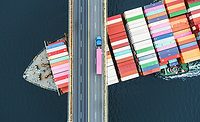2022 Distributor Roundtable
Industry leaders in the distribution of raw materials and chemicals share their thoughts regarding key issues impacting the adhesives and sealant industry.


.jpg?height=720&t=1662034708)
.jpg?height=720&t=1662034627)


.jpg?height=150&t=1662034708)
.jpg?height=150&t=1662034627)
How are issues surrounding the war in Ukraine, continuing inflations concerns, and talk of a recession impacting the supply chain? What are the factors currently causing transportation- and logistics-related challenges for raw materials and chemicals? Read answers to these and other questions as leaders in the distribution industry share their insights.
How are issues such as the ongoing war in Ukraine and inflation/recession concerns impacting today’s supply chain?
Michael Brennan, Director of Supply Chain & Logistics, Barentz: The war in Ukraine obviously has had the greatest impact within that specific region with closed or restricted capacity sailings at ports. Labor shortages are also an issue stemming from many Ukrainian citizens, strong in numbers in the Ocean Trade profession, are off fighting in the conflict. This has had a “knock-on” effect on European imports/exports overall as a reduction in capacity for the whole region. Ocean freight inflation will linger for the duration of the conflict.
Generally, inflation has impacted margins across the board in our industry, where commodity, freight, and fuel costs are at historically high levels. It has been imperative to increase lead times and deploy stronger forecasting capabilities within our value chain to mitigate inflation impacts. It’s still too early to tell on the impacts of the Recession beginning to appear in some regions/markets.
Sam Brooks, Marketing Director-CASE, Palmer Holland: Russia’s invasion of Ukraine has left a big impact on the global economy by weakening the post pandemic recovery and exacerbating already high raw material, fuel, logistics, and European energy costs. The ongoing war has also impacted the availability of raw materials sourced from Russia and Ukraine that are used in the adhesives and sealants industry, such as styrene isoprene styrene (SIS) and isoprene rubber (IR).
Record-setting inflation rates and uncertainty regarding a recession have impacted not only our industries but the entire global economy. We’re starting to see signs that demand is beginning to soften for the first time since May 2020 with a shift in consumer spending from goods to services. Indicators of potential disinflation are driving some of our adhesives and sealants customers to optimize their inventory levels of raw materials and final goods to reduce the risk of holding higher priced materials.
Chris Fitzgerald, Global Vice President, CASE, Rubber and Plastic Additives, Univar Solutions: It shouldn’t come as a big surprise at this point, but the war in Ukraine has had a domino effect on virtually every industry as well as inflation itself. Some industries have been impacted more directly than others, such as oil and gas. Given that much of the adhesives industry is tied to petrochemicals and petrochemicals are largely tied to oil, this has and will continue to have an ongoing impact on how our suppliers produce raw materials going into these markets. Further, we’ve seen a negative effect on freight and logistics costs in general.
But from our perspective, even in challenging and uncertain times, there are actions you can take to mitigate some of these issues. At Univar Solutions, we continue to look for opportunities to make improvements by investing in and leveraging technology, such as transitioning to electrified vehicles and warehouses powered by renewable sources. We recognize that it’s a progressive improvement and not something done overnight, but we’re already realizing the benefits of forward-thinking distribution that allow us to continue delivering products to our customers safely, efficiently, and sustainably.
What specific factors are currently causing transportation- and logistics-related challenges for raw materials and chemicals?
Brennan: It has been a rolling continuum of supply chain challenges for global material sourcing, from supply/demand imbalance globally to COVID lockdowns in China as well as the Ukraine crisis. We are starting to see some gradual improvement and stabilization in transportation capacity, though warehouse capacity is still at historic lows and inventory mix issues are still clogging port/inland channels and facilities.
Brooks: 2021 brought a complete supply chain dumpster fire. Demand far exceeded capacity, and this was paired with: a winter storm (The Great Freeze) slamming Texas; force majeures; allocations; new COVID variants; global port shutdowns and congestion; Suez Canal blockage; truck driver shortages; container shortages; and the costs of raw materials and shipping skyrocketing. The dominos just kept falling one by one in an already chaotic and messy environment.
In 2022, we continue to have this circular effect of continuous disruption. Just when it seems to be recovering, something else happens. Specific factors causing transportation and logistics challenges of raw materials and chemicals today are:
- Fuel costs
- China COVID lockdowns halting production of goods and materials and shutting down ports
- Shipping container shortage
- Current shipping backlog is still very large; there needs to be a catch-up period before we start to see impactful reduction in container rates
- Truck driver shortage
- U.S. port congestion is currently easing but we shouldn’t get exited just yet. As China lockdowns begin to ease, we are about to be flooded by hundreds of ships that are waiting to be loaded and sent off to our ports
- U.S. warehousing space is very tight
- Truck availability has improved, but demand is still significantly higher than pre-pandemic levels
Fitzgerald: There are a number of issues impacting transportation and logistics globally. Of course, it’s no secret that the cost of fuel is certainly a major challenge here. We’re seeing continued pressure on the cost of ocean freight, which is four to six times greater than 2020 rates. And the transportation industry overall continues to feel the effects of labor shortages, which impacts much of our inbound products.
On the outbound side, Univar Solutions is fortunate to maintain the largest private fleet of any chemical distributor, which enables us to have a stellar final mile capability for most products. Additionally, we maintain an expansive network of railcars and warehouse locations to support transloading. This further improves our efficiency and sustainability as well as that of our supplier partners, helping us minimize disruptions and maintain operations.
How can purchasing and supply chain managers optimize their relationships with distributors?
Brennan: The key is to emphasize greater collaboration, ideas, and best practices sharing. As an example, look at forecasting and lead times more openly and holistically across different business partners’ supply chains. Stronger two-way proactive communication is important for both the headwinds and tailwinds to give ample time for planning and mitigation. This will be key to continuous improvement as global challenges persist.
Brooks: Proactive communication and transparency between both parties on: forecasting, logistics challenges, lead times, what we’re seeing in the market, and expectations to optimize and ensure we are both successful in navigating this challenging environment.
Fitzgerald: Breadth of offerings throughout the range of a final product’s raw materials coupled with efficient sourcing from various suppliers is key to optimization and delivering on sustainability goals. We’re working with each of our supply partners to most efficiently source from their various locations into our network and avoid retracing routes, repackaging unnecessarily, or simply adding steps in the process. We welcome the opportunity to review complete sourcing opportunities with all our customers, as we often provide everything a customer needs to fulfill their raw material requirements within the primary markets we support.
Additionally, we offer technical resources to help our customers develop a playbook of offerings to enable flexibility and efficiency when raw materials are constrained. Being “spec’ed in” when raw materials become tight can create major problems for an adhesive manufacturer. We want to help develop secondary and tertiary plans for that adhesive in the event the preferred raw materials become unavailable or tight.
For more information, visit www.barentz-na.com, www.palmerholland.com, and www.univarsolutions.com.
Looking for a reprint of this article?
From high-res PDFs to custom plaques, order your copy today!









.jpg)
.jpg)